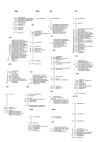A linkage map of the Atlantic salmon (Salmo salar) based on EST-derived SNP markers
- PMID: 18482444
- PMCID: PMC2405805
- DOI: 10.1186/1471-2164-9-223
A linkage map of the Atlantic salmon (Salmo salar) based on EST-derived SNP markers
Abstract
Background: The Atlantic salmon is a species of commercial and ecological significance. Like other salmonids, the species displays residual tetrasomy and a large difference in recombination rate between sexes. Linkage maps with full genome coverage, containing both type I and type II markers, are needed for progress in genomics. Furthermore, it is important to estimate levels of linkage disequilibrium (LD) in the species. In this study, we developed several hundred single nucleotide polymorphism (SNP) markers for the Atlantic salmon, and constructed male and female linkage maps containing SNP and microsatellite markers. We also investigated further the distribution of male and female recombination events across the genome, and estimated levels of LD between pairs of markers.
Results: The male map had 29 linkage groups and was 390 cM long. The female map had 30 linkage groups as was 1983 cM long. In total, the maps contained 138 microsatellite markers and 304 SNPs located within genes, most of which were successfully annotated. The ratio of male to female recombination events was either close to zero or very large, indicating that there is little overlap between regions in which male and female crossovers occur. The female map is likely to have close to full genome coverage, while the majority of male linkage groups probably lack markers in telomeric regions where male recombination events occur. Levels of r2 increased with decreasing inter-marker distance in a bimodal fashion; increasing slowly from approximately 60 cM, and more rapidly more from approximately 12 cM. Long-ranging LD may be consequence of recent admixture in the population, the population being a 'synthetic' breeding population with contributions from several distinct rivers. Levels of r2 dropped to half its maximum value (above baseline) within 15 cM, and were higher than 0.2 above baseline for unlinked markers ('useful LD') at inter-marker distances less than 5 cM.
Conclusion: The linkage map presented here is an important resource for genetic, comparative, and physical mapping of the Atlantic salmon. The female map is likely to have a map coverage that is not far from complete, whereas the male map length is likely to be significantly shorter than the true map, due to suboptimal marker coverage in the apparently small physical regions where male crossovers occur. 'Useful LD' was found at inter-marker distances less than 5 cM.
Figures





References
-
- Allendorf FW, Thorgaard GH. Tetraploidy and the evolution of salmonid fishes. In: Turner BJ, editor. Evolutionary Genetics of Fishes. New York, Plenum Press; 1984. pp. 1–46.
-
- Svardson G. Chromosome studies of salmonidae. Rep Swed State Inst Fresh-Water Fish Res. 1945;23:1–151.
-
- Wright JE, May B, Stoneking M, Lee GM. Pseudolinkage of the duplicate loci for supernatant aspartate aminotransferase in brook trout, Salvelinus fontinalis. J Hered. 1980;71:223–228. - PubMed
-
- May B. The salmonid genome: Evolutionary restructuring following a tetraploid event. PhD thesis. Ph.D. Pennsylvania State University; 1980.
-
- Wright JE, Johnson K, Hollister A, May B. Meiotic models to explain classical linkage, pseudolinkage, and chromosome pairing in tetraploid derivative salmonids genomes. Isozymes Curr Top Biol Med Res. 1983;10:239–260. - PubMed
Publication types
MeSH terms
LinkOut - more resources
Full Text Sources
Other Literature Sources
Molecular Biology Databases
Research Materials

